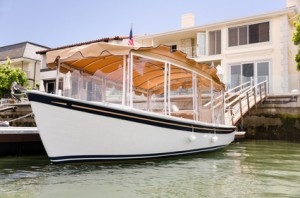When one of the most important aspects of house hunting becomes finding a suitable parking place for your boat, it’s time to admit that you’re a boater for life.
You’re also using your noggin. When marina fees can run up to $500 a month in some parts of the country – and that’s without the additional cost of electricity – it might make more financial sense to purchase a home on the water, with a dock for your boat.
Whether it’s your main home or a vacation place, there are a few key things to consider before deciding on a particular dock that just happens to come with a house.
How Big and How Deep?
 Dock size and the berth’s depth are the most important considerations, and for obvious reason. What’s not so obvious, however, is that you shouldn’t rely on property descriptions to tell the truth about either of these features.
Dock size and the berth’s depth are the most important considerations, and for obvious reason. What’s not so obvious, however, is that you shouldn’t rely on property descriptions to tell the truth about either of these features.
“Frank’s boat was 46 feet, and although the properties were advertised as being able to accommodate his pride and joy, we found out the hard way this wasn’t always the case. While the slip wasn’t large enough, the depth was, thus accommodating his draft (and if the draft was an issue, then dredging would have become a concern),” explained Samantha DeBianchi, an agent and real estate expert who appears on the TV show “Million Dollar Listing Miami.”
She goes on to advise buyers to make a list of their boat’s specs, down to the last detail, so they can confirm with the listing agent that the boat will fit. Why waste time looking at homes that won’t work for you?
Consider bridges in the surrounding waterways as well. A fixed bridge that won’t accommodate the height of your boat at high tide is a deal killer.
If you’re selling a home that’s ideal for a boat owner, double check the MLS listing and all marketing materials for accurate details about your slip, so you don’t accidentally mislead a buyer. Everyone makes mistakes and, for many, it’s easy to goof when working with numbers.
Nautical Commute Time
Just as you’d think twice about purchasing a home with a two-hour commute to work, the amount of time it will take you to travel from your new home to the open water should be a main point of interest. Especially for boat owners who use the craft frequently, it’s important to determine how long is too long, and set a limit.
Be Ready for Inspections
For many boat owners, it isn’t enough to just have the home inspected. You’ll also need to be prepared to have the seawall looked at by a licensed contractor.
DeBianchi noted that the inspection will involve the scrutiny of the seawall for cracks, bowing, holes and insufficient batter pilings. The inspector should also check the dock pilings.
Ensure that all utilities to the dock are up to code and safe before your inspection, as well.
Zoning Concerns
Finally, all of the previous advice doesn’t mean a thing if the zoning in your area prohibits either the type of the size of your craft. Your real estate agent can help navigate you through city, county and other local zoning laws and restrictions.
Purchasing a home that must include a dock for your boat brings with it a whole new list of concerns. Understand that it’s not a quick process, and that using a methodical, step-by-step process is the key to your success. Working together proactively with your agent will help ensure that the process runs smoothly.
